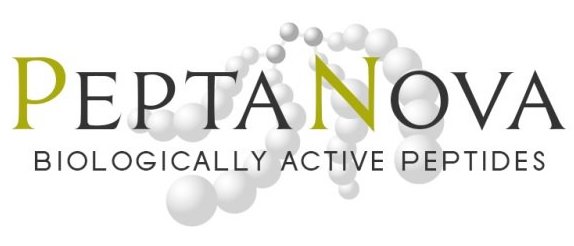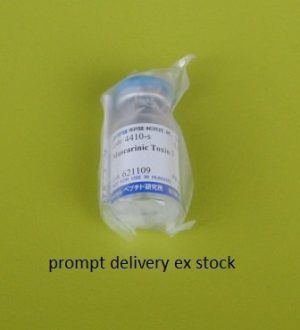GsMTx-4
(Spider, Chilean Rose Tarantula, Grammostola spatulata)
4393-s 0.1 mg | 215.00 EUR
Gly – Cys – Leu – Glu – Phe – Trp – Trp – Lys – Cys – Asn – Pro – Asn – Asp – Asp – Lys – Cys – Cys – Arg – Pro – Lys – Leu – Lys – Cys – Ser – Lys – Leu – Phe – Lys – Leu – Cys – Asn – Phe – Ser – Phe – NH2
| (M.W. 4095.8) | C185H273N49O45S6 |
Synthetic Product (disulfide bonds between Cys2-Cys17, Cys9-Cys23 and Cys16-Cys30)
The purity is guaranteed to be higher than 99% by HPLC
Inhibitor for Cation-Selective Stretch-Activated Channels / Atrial Fibrillation Inhibiting Peptide
GsMTx-4 interacts to the group of mechanosensitive ion channels (MSCs) which are ubiquitous from unicellular to multicellular organisms and participate in numerous physiological processes including touch and pain sensation, salt and fluid balance, blood pressure control, cell volume regulation, and turgor control [Physiol. Rev., 81, 685 (2001)]. Analysis of the functions mediated by these channels can be performed by utilizing a specific blocker with high selectivity to the particular channels. In the research of stretch-activated ion channels (SACs), one of MSCs, cationic metal, Gd3+, and cationic compounds including amiloride, and cationic antibiotics have been used as blockers, but were reported to be non-selective (lack of specificity). In 2000, Professor F. Sachs of State University of New York at Buffalo discovered a peptidic toxin named GsMTx-4 in the venom of the tarantula Grammostola spatulata and repoted it to possess a specific blocking activity for stretch-activated currents [J. Gen. Physiol., 115, 583 (2000)]. GsMTx-4 blocks:
- SAC current in outside-out patches from adult rat astrocytes (Kd=630 nM);
- swelling-activated whole cell current (an inwardly rectifying cation selective current) in cardiac myocytes at 400 nM (but not an outwardly rectifying Cl– current); and
- MSC current in normal rat kidney cells at 5 µM [[J. Gen. Physiol., 115, 583 (2000), Toxicon, 42, 263 (2003)].
Also, this peptide inhibits the atrial fibrillation associated with dilatation at 170 nM (anti-arrhythmic activity)[Physiol. Rev., 81, 685 (2001), Nature, 409, 35 (2001)].
Primary sequence of GsMTx-4 has been clarified recently by cDNA cloning to be a 34- residue peptide possessing a post-translationally modified amide structure at its carboxyl-terminus[Toxicon, 42, 263 (2003)]. Three disulfide linkages in the molecule were connected in the pattern of Cys1-Cys4, Cys2-Cys5, and Cys3-Cys6 (Cys numberings from the amino-terminus) during the determination of its solution structure, indicating that GsMTx-4 is a member of “inhibitor cystine knot” peptides [J. Biol. Chem., 277, 34443 (2002)]. GsMTx-4 should prove to be a useful tool for the study of the biological events initiated by the activation and inactivation of SACs.
References:
- T.M. Suchyna, J.H. Johnson, K. Hamer, J.F. Leykam, D.A. Gage, H.F. Clemo, C.M. Baumgarten and F. Sachs, J. Gen. Physiol., 115, 583 (2000) (Original)
- F. Bode, F. Sachs and M.R. Franz, Nature, 409, 35 (2001) (Pharmacol.)
- R.E. Oswald, T.M. Suchyna, R. McFeeters, P. Gottlieb and F. Sachs, J. Biol. Chem., 277, 34443 (2002) (Seq.; Correction of C-Terminal Sequence, S-S Bond)
- K.L. Ostrow, A. Mammoser, T. Suchyna, F. Sachs, R. Oswald, S. Kubo, N. Chino and P.A. Gottlieb, Toxicon, in press (Primary structure; cDNA sequence / Pharmacol.)
Links to publications that use our peptide GsMTx-4 | code 4393-s:
- Effect of hypoxia on TRPV1 and TRPV4 channels in rat pulmonary arterial smooth muscle cells
- TRPA1 Is Differentially Modulated by the Amphipathic Molecules Trinitrophenol and Chlorpromazine
This peptide is distributed through Peptide Institute, Inc. under the license of the Research Foundation of the State University of New York. The use for any purpose other than research is strictly prohibited.
For Laboratory use only! Not for Drug Use!



